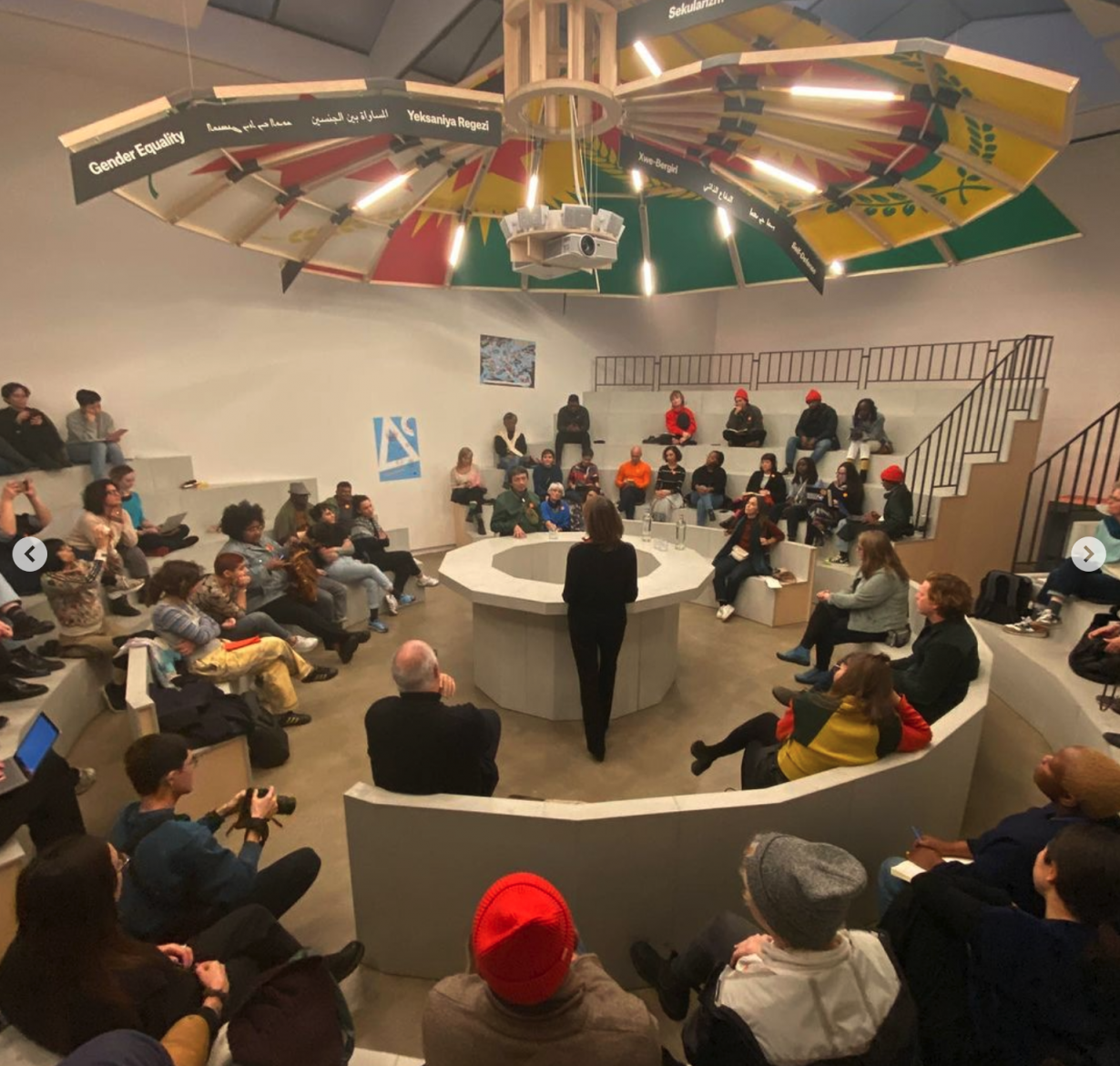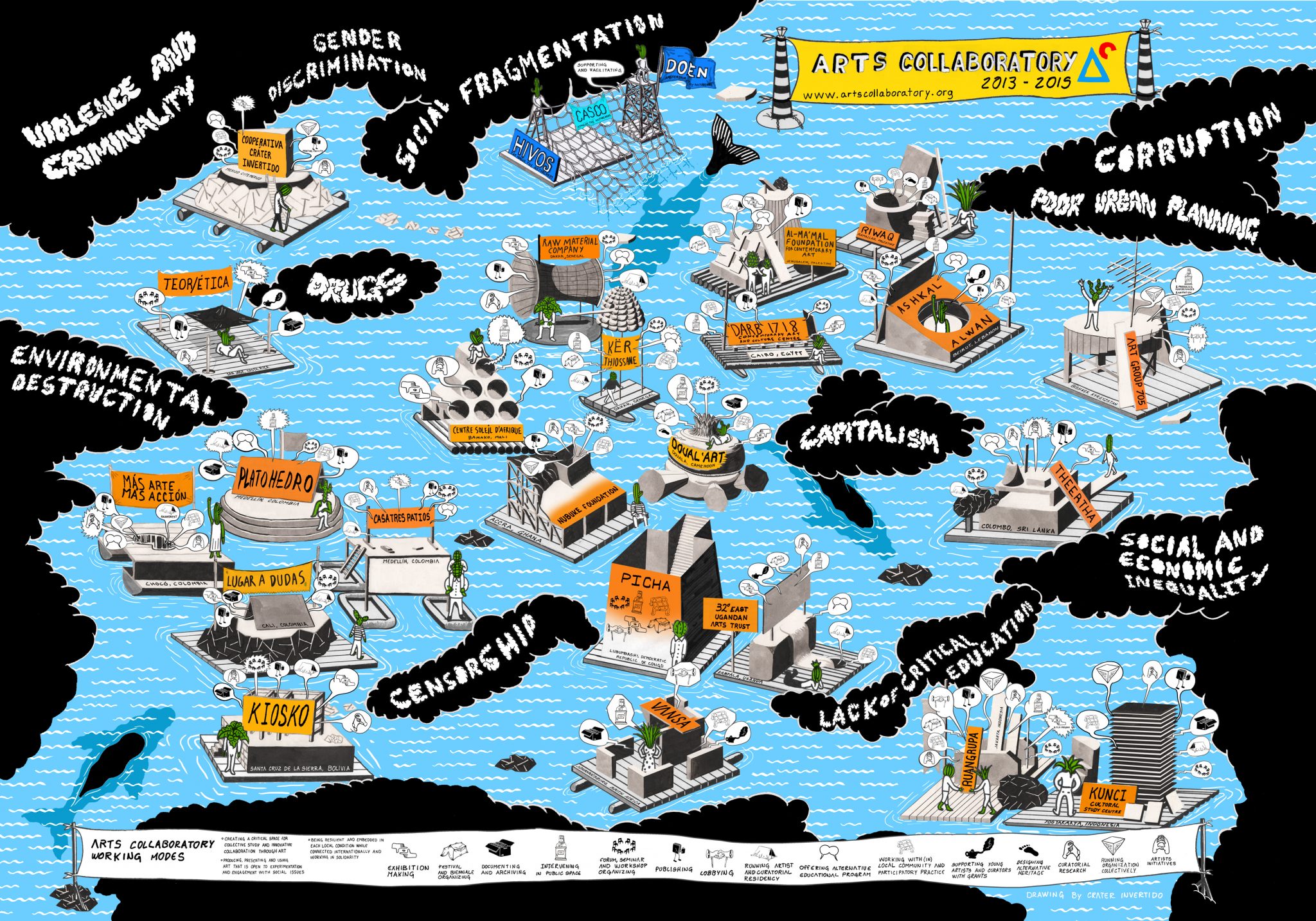The impact of Arts Collaboratory can be felt throughout the artworld
In his seminal 1972 book How Europe Underdeveloped Africa,historian Walter Rodney dispelled the persistent myths that colonialism was somehow beneficial to those who were colonised. One such myth is the benefit of the railroads that colonial powers constructed, however Rodney’s research showed that the rail lines often went directly from the mines to the coast, intentionally bypassing urban areas, hence what was often left after independence was an infrastructure of extraction. A similar question may be asked of what to do with the outmoded infrastructure of contemporary art – the institutions in few cities that for many years monopolised discourse, upholding a racist notion of what contemporary art is, based on a narrow concept of art and culture. This question is especially timely now when the multiplicity and diverse understandings of art, culture and their histories are being reasserted globally.
This question of how to re-use the institutions of contemporary art has been experimented with in the collective curation of documenta 15 – initiated by Jakarta-based ruangrupa – and the ongoing transformation of HKW in Berlin into a leading decolonial European institution embracing the plurality of cultures. These two examples have in common a connection to the ongoing work of an important contemporary art network today, which is barely known outside of its members. Arts Collaboratory is a network of 25 art spaces, mainly from the Global South, including Raw Material Company, Dakar; Kunci, Yogyakarta; Lugar a dudas, Cali; Ashkal Alwan, Beirut; ruangrupa, Jakarta; and Cooperativa Cráter Invertido, Mexico City, among others. It started in 2007 as more of a traditional art network like the long-running Triangle Network, begun in 1982 and with partnerships in 40 countries, only with the difference that its initiators, the Dutch NGOs DOEN Foundation and Hivos and the publicly funded Mondriaan Fund, provided financial support for the art institutions while wanting to ease bureaucracy for their grantees, provide a platform for them to exchange knowledge and foster South-South art institutional connections. The relationship between Global North funders and Global South arts organisations shifted over time, especially through the shared experiences at a series of Assemblies (Colombia 2011; Indonesia 2014; Senegal 2015; Kyrgyzstan 2016; Costa Rica 2017; Lebanon, Palestine and Jordon 2018; Uganda 2019) that were facilitated by local member organisations in collaboration with the Utrecht-based Casco Art Institute, Hivos and DOEN Foundation.

These gatherings were an opportunity to discuss shared concerns around precarity, censorship and the different roles that arts organisations play in their own communities and contexts. The conversations and relationships that were built during the Assemblies provided the participants with an expansive knowledge of artists, art scenes and cultural contexts across Africa, Asia, Latin America and the Middle East. Collaborative projects emerged between the art institutions, including a translocal school, staff exchanges and a joint lobbying group. The experience of the Assemblies led to an affective transformation in the group from one primarily focused on securing funding to a translocal community based on trust and friendship. This intense affective transformation also paralleled a pronounced shift towards self-governance in the network.
Instead of Global North funders giving grants and undertaking reporting, in 2015 the art spaces and funders developed a proposal for the network’s members to take one bulk grant of €3 million and distribute it among themselves, with their own internal annual peer-review accountability and reporting based on notions of commonwealth and shared governance. Alongside this transformation, the Global North organisations DOEN Foundation and Casco were invited by the art spaces to be part of the network instead of administrators, funders or facilitators. This changed the power dynamics so that everyone was now in the same network instead of background facilitators, also making the affinities that had formed over the years more transparent.
The effects of the experience in Arts Collaboratory reach beyond its member institutions. Ashkal Alwan’s director Christine Tohme conceived of a decentralised Sharjah Biennial 13 that included Dakar, Ramallah and Beirut – a nod to the translocal collaboration that defines Art Collaboratory, and the biennial included several AC collaborators as well. Curator Koyo Kouoh, who was the director of Raw Material Company, went on to be the founding director of Zeitz MOCAA, the first museum of contemporary art in Southern Africa. Marie Hélène Pereira, who followed her as director of Raw and is now senior curator of performance practice at HKW, co-curated the exhibition Scattered Seeds in Cali (2015–17) as part of an Arts Collaboratory institutional residency. Perhaps the most prominent impact of Arts Collaboratory was Documenta 15, where ruangrupa’s curatorial structure roughly mirrored Arts Collaboratory itself. The underlying principles of Documenta were collectivity, resource building and equitable distribution, from which ruangrupa set up a network with 14 members, growing to 68 members, who were given budgets to work in affinity with the other members towards sustainability for their practices and ecosystems. Among these members were a number of Arts Collaboratory organisations, including as Más Arte Más Acción, Chocó, and Centre D’Art Waza, Lubumbashi, and even Arts Collaboratory itself as an entity. Gertrude Flentge from DOEN Foundation also joined Documenta 15’s artistic team.
These are just a few examples of the external effect of Arts Collaboratory has had on the art world over the past decade. However, the most important impact of the network remains internal across the institutions involved and their communities. To the wider art world, Arts Collaboratory largely remains in the background due to its express purpose to support organisations doing their own work.

Today, the network is facing quite a different challenge. On the eve of the next Assembly, which is taking place through 23 November in the Netherlands, the funding has been finished and the institutions need to decide whether they will keep Arts Collaboratory and potentially fund it themselves or what a role for future funders like DOEN Foundation would be. Paradoxically, this completely inverts the original dynamic of the network from grant receivers to potentially collective donors. The co-ownership of the network would no longer be just a shared feeling but a shared financial reality. This transition would potentially transform Arts Collaboratory once again, this time shifting into an interdependent ecosystem in which financial, affective and artistic support all flow in multiple directions.
Some of the difficult discussions faced in this Assembly include the question of membership: the member organisations have largely stayed the same over the duration of Arts Collaboratory and no new organisations have been added since 2012. The feelings of trust and friendship that have become foundational to the network are contained within this group of art spaces, even while directors and staff have changed; could a process be developed which would facilitate the entry of new organisations and build the same level of trust? Moving forward, as financial contributions might be shared, will all the member organisations opt to stay in the network? And, with a potentially reduced budget, how can an ecosystem that spans multiple continents continue close collaboration in terms of finance as well as environmental impact? These are important prefigurative questions that Arts Collaboratory is already experimenting with and by doing so, it is developing new forms of collaboration. It is through these forms that translocal art institutions are impactful now and can shape an art world in a post-capitalist future.
Jason Waite is a curator, writer and member of the collective Don’t Follow the Wind.
